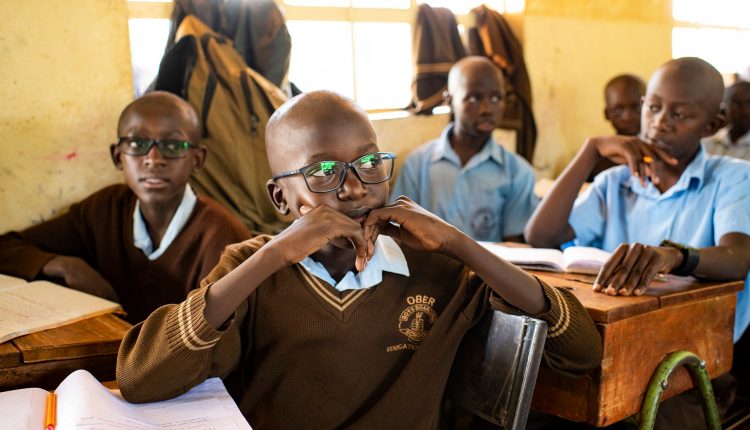
The Albino Foundation Public Notice
· The majority of people with ‘blindness’ live in Nigeria, other poor countries
· By 2050, half of the world will be shortsighted, experts warn. 20% of world population at risk of impaired vision
· Neglected cataract, faulty refractive error leading causes of blindness
· Ophthalmologist claims bitter kola-based eye drops clear immature cataracts
· Journalists are susceptible to eye problems due to their constant use of computers, other gadgets
· World Sight Day (WSD) is commemorated 14th of October every year
To commemorate World Sight Day (WSD) on October 14, experts have warned that 90 percent of people with sight today, will experience short-sightedness in Nigeria and other low and middle-income countries. WSD is an annual day of awareness held on the second Thursday of October to focus global attention on vision impairment, including blindness. The theme for this year’s WSD was: Love Your Eyes.
The expert bodies, including the International Agency for the Prevention of Blindness (IAPB), World Health Organisation (WHO), Ophthalmological Society of Nigeria (OSN) and a consultant ophthalmologist at College of Medicine University of Lagos (CMUL) and Chairman, Lagos State Traditional Medicine Board, (LSTMB), Prof. Adebukunola Adefule-Ositelu, said sight loss costs global economy $411 billion in productivity every year and contributes to social inequality.
They said un-operated cataracts and uncorrected refractive error are leading causes of blindness; while other causes such as age-related macular degeneration, glaucoma, diabetic retinopathy, infectious diseases of the eye, and trauma, cannot be ignored and need to be addressed.
The experts warned that half of the world’s population may be shortsighted by 2050 and up to one-fifth of those numbers at significant risk of blindness if current trends continue.
They gave reasons why sight loss is more likely to affect women than men as 55 percent of people with visual impairments are female compared to 45 percent of males. They, however, said 90 percent of sight loss can be prevented if identified early as majority of the cases can be treated with simple interventions.
According to them, regular screening and eye checks can identify eye conditions such as glaucoma or diabetic retinopathy before they even have effect on an individual’s sight and can be corrected to prevent sight loss.
Adefule-Ositelu noted that bitter kola-based eye drops clear immature cataracts and are more effective in those free from diabetes mellitus.
Adefule-Ositelu told The Guardian: “We know that eyes in children at birth are hypermetropic and continue to develop until the age of three. However, when children now have myopia, it may be genetically determined or could be that the eyes are growing faster than it should in relation to their bodies and age.”
On the association between diabetes and blindness, the ophthalmologist said: “When there is excess sugar in the body, called hyperglycemia, the lenses in eyes also are bathed in such fluid and as such their metabolism becomes deranged. They begin to loose clarity, which gets worse with time and causes cataract blindness.
“The vessels of the retina are usually also adversely affected after many years of deprivation. Retina is the sensitive layer in the eyes that form nerve fibers called optic nerves. These nerves connect the eyes with the brain. The retinal vessels can be affected to leak and bleed and thereby cause malfunctioning of the retina, with poor transmission of messages to and from the brain. Thus, visual impairments for long, short and central visual acuities can develop. The disease calls for strict management.”
On efforts to reverse blindness in Nigeria, Adefule-Ositelu said corneal transplants could be done to replace damaged or opaque cornea. “The cornea is the transparent layer in front of the eye that allows us to see the brown/black iris behind. When it loses its transparency, the eye cannot see and cannot allow the eye to send message to and back from the brain. Cornea transplant is being successfully done in Nigeria. Organ/eye donations are very poorly accepted by Nigerians for cultural and spiritual values,” she said.
On if natural medicine has significant roles to play in eye care, the ophthalmologist said: “I can speak for the Lagos State Traditional Medicine Board of which, I am the current Chairman. Our generation has been managing their eye problems even before the advent of modern medicine. Such resulted in my extensive researches on Garcinia kola (bitter kola) nuts. We have traditional eye drops that clear immature cataracts, more effective in those free from diabetes mellitus. No one will or should ever try peppers on the eyes.”
President of OSN, Dr. Abiola Oyeleye, said interventions that addresses the needs associated with uncorrected refractive error and un-operated cataracts are among the most cost-effective and feasible health interventions available. He said key challenges in meeting the growing demand for these interventions include the ability to provide services for underserved populations and ensuring quality service delivery.
Oyeleye said achieving these targets requires the combined and proactive efforts of all stakeholders, including governments, civil society, international organisations and the WHO secretariat working together in innovative ways to address the eye care needs.
According to IAPB, sight loss is a growing problem for people all over the world. The number of people affected by sight loss has nearly doubled in recent decades, growing from around 560 million in 1990 to over 1.1 billion today. By 2050, it is expected to have grown by more than half, with projections indicating that nearly 1.8 billion people will be affected by sight loss.
IAPB noted: “90 per cent of people with sight loss live in low-and middle-income countries. Although Asia is home to 59 per cent of the global population, 64 per cent of people with sight loss live in these regions. High-income countries including those in North America and Europe make up 14 per cent of the world’s population but only seven per cent of people with sight loss live in this region.
“Sight loss is more likely to affect women than men. The gender difference is partly due to women having a longer average life expectancy than men. However, there are also social and economic barriers that can prevent women receiving treatment. These include lack of access to the economic resources required to pay for eye care, inability to travel for eye treatment services and lack of access to information about potential treatments.
“Women are 40 per cent less likely to utilise eye care services than men and often find their medical needs are deprioritised. In some parts of the world, if girls are blind or significantly vision impaired it is almost impossible for them to access education, locking them into a lifetime of poverty.”
According to IAPB, “sight loss costs the global economy $411 billion in productivity every year and contributes to social inequality. However, tackling preventable sight loss is one of the most cost-effective health interventions that governments can make – for every £1 spent on preventing avoidable blindness, £5 is returned.”
It noted: “Regular screening and eye checks can identify eye conditions such as glaucoma or diabetic retinopathy before they even have an effect on an individual’s sight and can be corrected to prevent sight loss.”
MEANWHILE, the #LoveYourEyes campaign, coordinated by IAPB, has reiterated the need for people to get their sight checked, especially now with the pandemic and worldwide lockdowns leading to more time spent on screens, less time spent outdoors, and missed sight tests.
A study in China found the number of kids being diagnosed with shortsightedness doubled in 2020 compared to 2019. Another recent study found that in the United Kingdom, almost 3,000 people are estimated to have lost vision due to delays in the identification and treatment of eye disease, and 4.3 million fewer people received sight tests in 2020, compared to 2019.
Unit Head for Vision, Disability and Rehabilitation at the WHO, Alarcos Cieza, said: “The last year has been incredibly tough on people, and it has been tough on their eyes too. We have found ourselves spending more time looking at screens, spending less time outside, and we have also had to miss sight check-ups. However, there are a few easy things we can do to show our eyes and our loved ones’ eyes, especially our children’s, some extra care.
“Firstly, book an eye test. Prevention really is better than cure and an eye test often helps detect issues (beyond just your eyesight) before you may notice them yourself.
“Secondly, follow the 20-20-20 rule. This means taking a 20-second break to view something 20 feet away every 20 minutes when using devices.
Thirdly, encourage your child (children) to play outside regularly and spend at least 90 minutes each day outside. This will give your child a screen break and allow them to focus on different distances and spend time in natural light, which can help keep your child’s eyes healthy.
“Finally, it is important to wear your glasses as instructed by your eye health professional. It isn’t true that glasses make your vision worse. They will not only help to see clearly but help prevent eyes from straining to see things.”
MEANWHILE, the Bauchi State council of the Nigerian Union of Journalists (NUJ) yesterday conducted free eye screening for its members to commemorate the World Sight Day. Speaking before the commencement of the free eye screening, the council chairman, Comrade Umar Sa’idu, said in the course of performing their duty, journalists made use of devices, including computers, laptops, phones, among others.
These, the chairman said, expose them to the adverse rays, submitting that without good eyes, journalists cannot perform their primary responsibilities effectively.
According to Sa’idu, the eye screening served as an opportunity for NUJ members in the state to check their sights in view of the adverse rays they are exposed to on a daily basis.
While emphasising constant eye screening and treatment, Sa’idu revealed that research showed that four out of every 10 people in contact with computers always come up with one eye problem or the other.
THE Imo State chapter of the Nigerian Optometric Association (NOA) has said 80 per cent of eye problems are avoidable. The association said a survey carried out in six communities in the state revealed that 39 per cent of the population are visually impaired, while 6.9 per cent are completely blind.
Speaking to journalists in Owerri, the Imo State capital, yesterday, the association chairman, Dr. Chinaka Nwosu, cautioned Nigerians against not taking proper care of their eyes considering the importance of the eye to mankind.
According to Dr Henrietta Ifechukwude Monye, an Ophthalmology Senior Registrar at the University College Hospital, Ibadan, in Nigeria, about one in every 25 persons aged 40 years and older is blind; and 84 per cent of blindness could have been prevented or treated.
Monye said visual impairment is the partial or complete inability of a person to see. “It includes problems with both distant vision and near vision. About half of the people that are visually impaired are needlessly so because, though their eye conditions could have been prevented or treated, they do not have access to basic eye care.
Inclusive News Network



